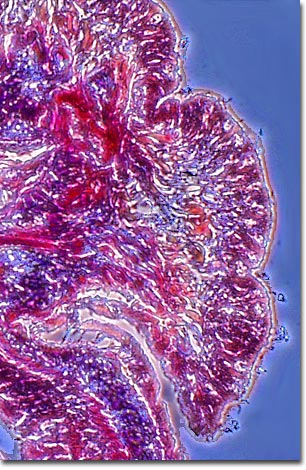Phase Contrast Image Gallery
Metridium
This genus of sea anemone is common throughout the world's oceans. The plumose anemone, Metridium senile, is found off both coasts of North America and is often used as a specimen for dissection in the classroom. It is usually white but also occurs as tan, brown, or orange.

Plumose anemones are often found attached to docks and pilings and look like gelatinous blobs when the tide is out. Underwater, they are quite beautiful as their tentacles open up like flowers. Adults feed on small plankton that they capture with their stinging cells, or nematocysts. They are preyed upon by several different kinds of animals, such as nudibranchs and sea stars. Although sea anemones reproduce sexually, species of the Metridium genus are able to reproduce asexually as well, by breaking off pieces of their pedal disk (the body part that attaches to the substrate).
Sea anemones are bottom-dwelling, sedentary marine animals that can be found living in a variety of habitats. They occur from shallow tidal zones to depths of more than 30,000 feet (10,000 meters) and from tropical waters and deep-sea thermal vents to the Antarctic seabed. They are one of the simplest animals, but the nematocysts that cover their tentacles are one of the most complex structures in the animal kingdom.
Many anemones live in close association with other organisms. Some species host symbiotic algae within their cells, which may be a major source of energy for them. The algae perform photosynthesis and provide energy resulting from that process to the anemones. The sea anemone Adamsia palliata and the hermit crab Eupagurus prideauxi are always found living together, never alone. When a crab adopts a shell for its home, it finds an anemone and places it on the top of the shell. When it outgrows the shell and moves to a new one, it moves the anemone as well. Ten species of fish-eating anemones are host to anemone fish, which are coated with protective mucus that allows them to live amongst the poisonous tentacles, safe from predators. The fish, in turn, remove parasites and defend the anemones from predators immune to the stinging tentacles. They also may feed the anemone by literally bringing food to it.
BACK TO THE PHASE CONTRAST GALLERY
